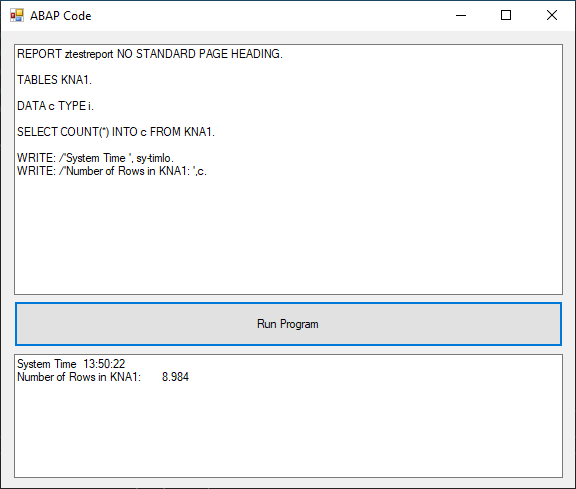Warning: Deprecated documentation
You are using the old version of the online help for ERPConnect.
Make sure to use the documentation within the new HelpCenter for ERPConnect.
The class ABAPCode offers nearly unlimited possibilities.
You can execute ABAP code on the fly and retrieve the result in a string array.
The following sample shows how to create a simple ABAP interpreter that executes a dynamic SQL statement.
Create an ABAP Interpreter #
Follow the steps below to crate an ABAP interpreter:
- Connect to the SAP system using
R3Connection. - Add a new line of code to the dynamic report using
AddCodeLine. - Execute the report using
Execute. - Read the result set (regarding the ABAP list) using
GetResultLine.
using System;
using ERPConnect;
using ERPConnect.Utils;
// Set your ERPConnect license
LIC.SetLic("xxxx");
// Open the connection to SAP
using var connection = new R3Connection(
host: "server.acme.org",
systemNumber: 00,
userName: "user",
password: "passwd",
language: "EN",
client: "001")
{
Protocol = ClientProtocol.NWRFC,
};
connection.Open();
const string code =
"""
REPORT ztestreport NO STANDARD PAGE HEADING.
TABLES kna1.
DATA c TYPE i.
SELECT COUNT(*) INTO c FROM kna1.
WRITE: /'System time ', sy-timlo.
WRITE: /'Number of rows in KNA1: ', c.
""";
var abapCode = new ABAPCode
{
Connection = connection
};
string[] lines = code.Split('\n');
foreach (string s in lines)
{
abapCode.AddCodeLine(s.Trim());
}
if (abapCode.Execute())
{
for (int i = 0; i < abapCode.ResultLineCount; i++)
{
Console.WriteLine(abapCode.GetResultLine(i));
}
}
else
{
Console.WriteLine($"ABAP Error: {abapCode.LastABAPSyntaxError}");
}
